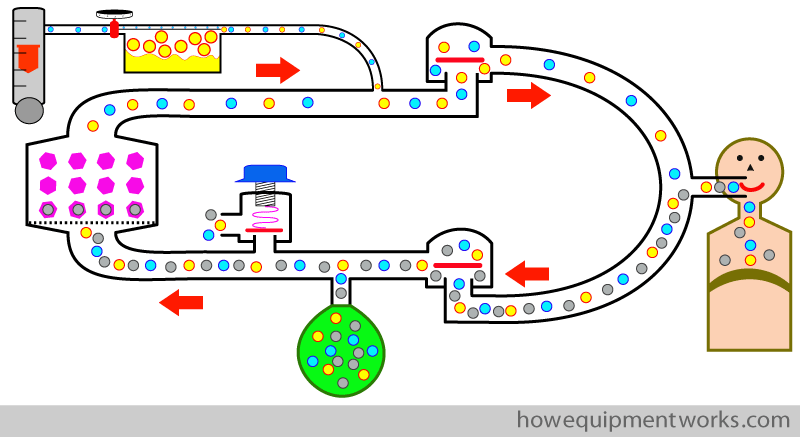
We will discuss the following aspects. Please scroll down and start reading.
- Basic circle system
- Positive pressure ventilation
- Advantages of the circle system
- Extra details on some of the components
Let us make a circle breathing system!
A “breathing system” is an arrangement of tubes and other components that transports gases between the anaesthetic machine and the patient. A very common breathing system used in anaesthesia is the “circle breathing system” and I will introduce its functioning to you. This breathing system has many advantages which we will discuss later. To make things easier, I will from now on, shorten “the circle breathing system ” to “circle system “.
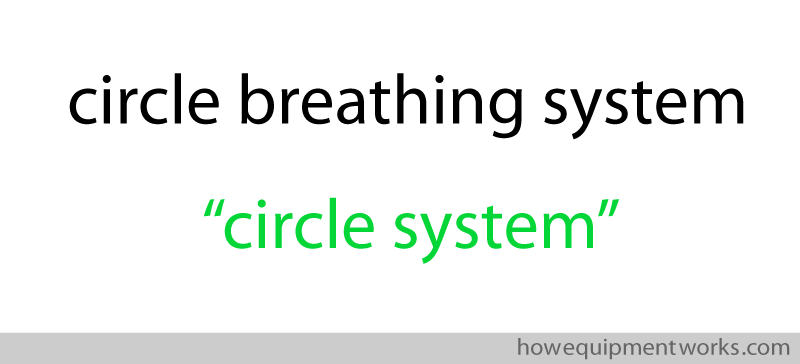
I think a good way to understand how the circle system works is to “construct” one, step by step. Let us begin “making” our circle system by drawing a circular tube.
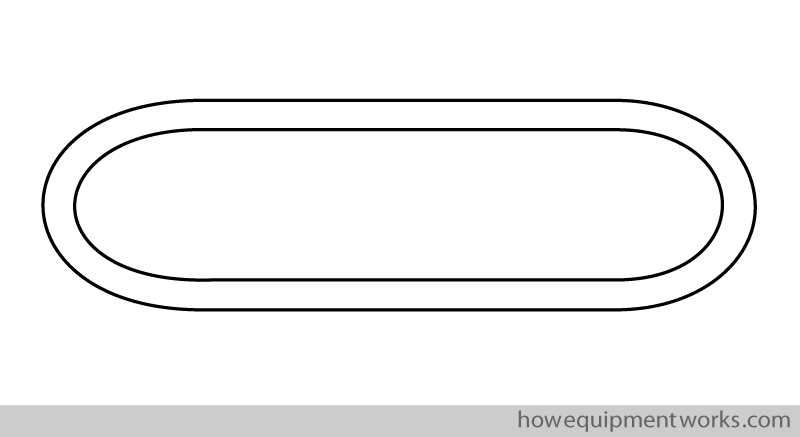
The gases inside the circle system go around in a circular way.
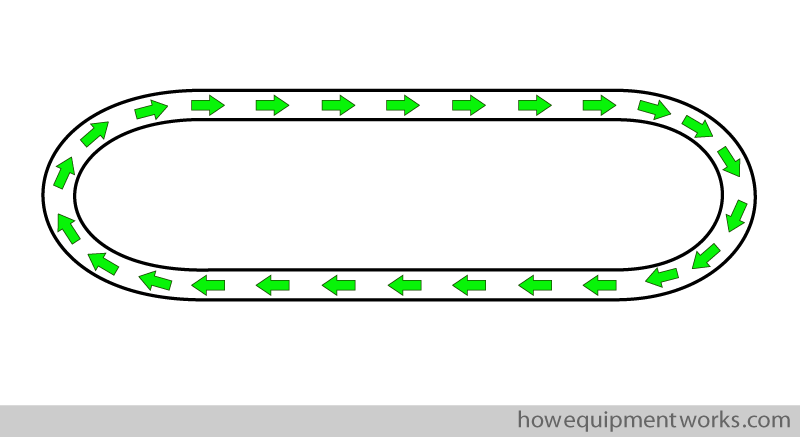
Let us start adding parts to our circle, in a step-by-step way. The first part I would like to add to the circle is a patient!
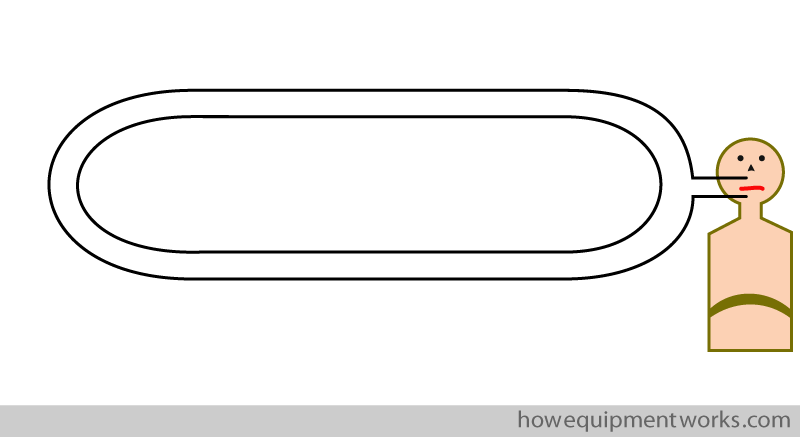
However, though we have connected the patient to the circle, he will unfortunately not be able to breathe in or out from it. This is because the circular tube is made of a non-stretchable material and therefore it cannot expand to accept the patient’s expiration, nor can it contract when the patient tries to inspire from it.
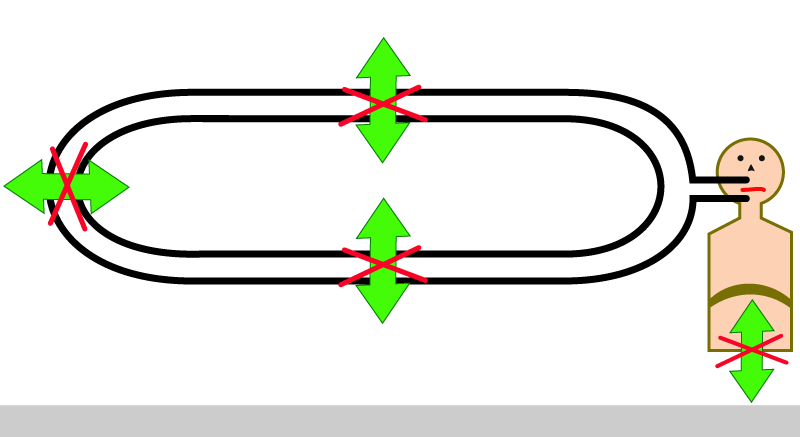
To allow the patient to breathe in and out, we attach a flexible bag ( called a reservoir bag ) to the circle system. Now the patient can breathe, through the tubes, into and out of the flexible reservoir bag.
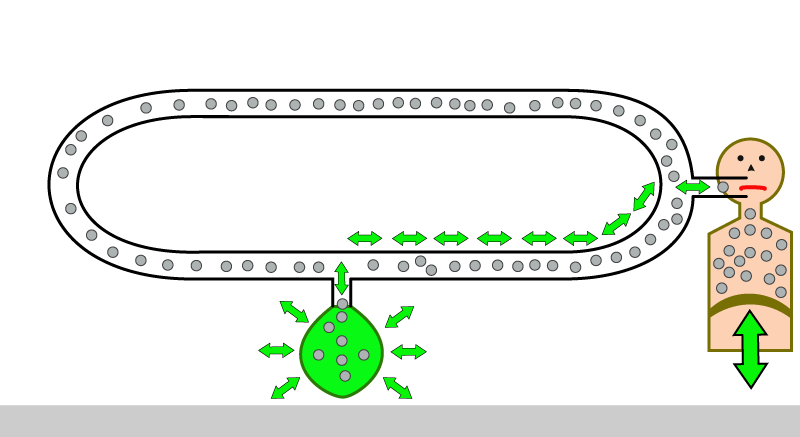
However, if we leave our patient like this, he will not survive, since we are forgetting to give him something vital for life. We need to urgently give our patient oxygen! The oxygen (and other gases) come out of the flow meters of your anaesthetic machine. The flow meters allow you to control the flow of the various gases that you supply to your patient. The total flow of gases coming out of the flow meters is called ” total fresh gas flow” or more commonly, simply referred to as, “fresh gas flow”.
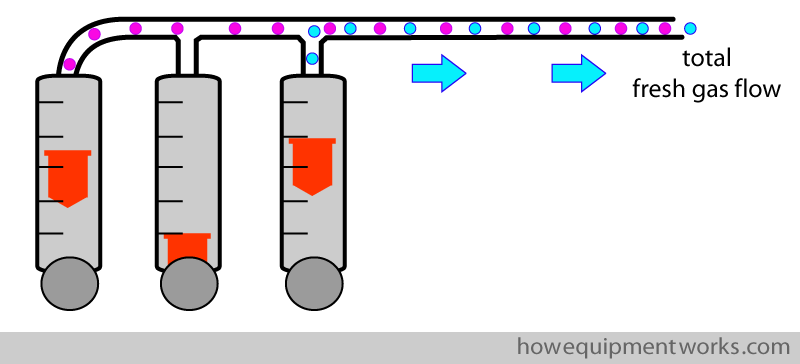
So, to keep our patient alive, we supply fresh gas flow ( containing oxygen, shown as blue dots ) from the flow meters into the circle system.
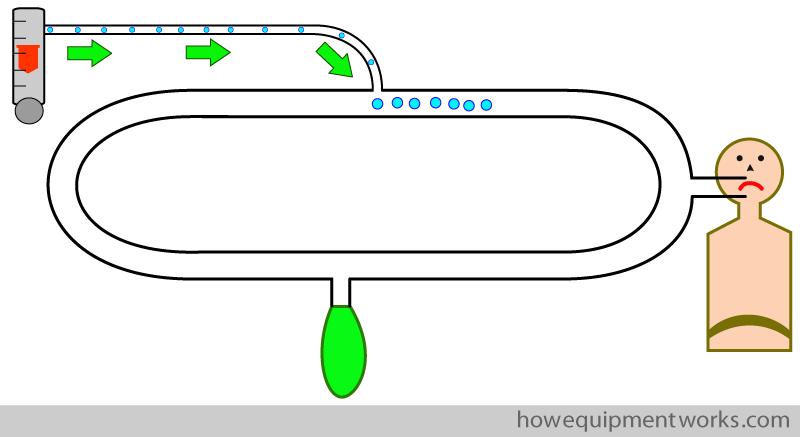
Unfortunately, there still is a problem. Though we are giving oxygen into the circle, it is not reaching the patient! The reason for this is that he is breathing in his own expired air (shown in grey) which of course does not have much oxygen. This breathing of his own oxygen-depleted air will make him hypoxic!

As I will explain to you, the solution is to “force” the patient to inspire from one section of the circle and to expire into a different section of the circle. I will explain later how we “force” the patient to do this. In the diagram below, we ” force ” the patient to inspire from the circle system tubing labelled as ” i “.
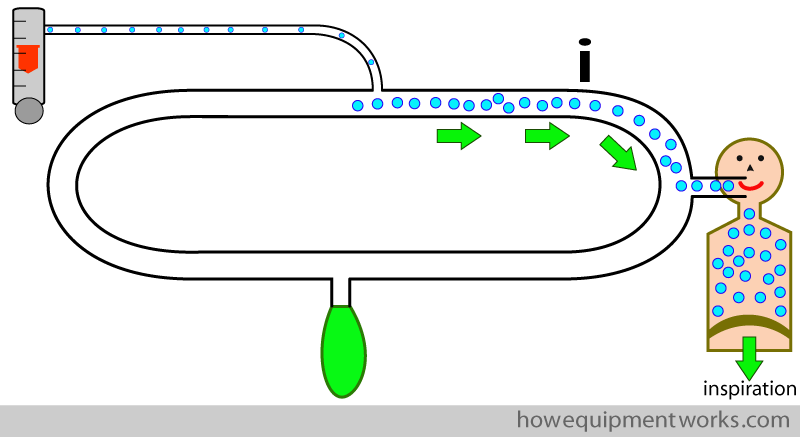
We then “force” our patient to expire to a different part of the circle system ( the part labelled “e “). I.e. the inspiratory pathway and the expiratory pathway are separate.

In this way, the patient will inspire oxygen-rich fresh gas rather than the gases he just expired. I will next explain how we will “force ” the patient to breathe the way we just discussed.
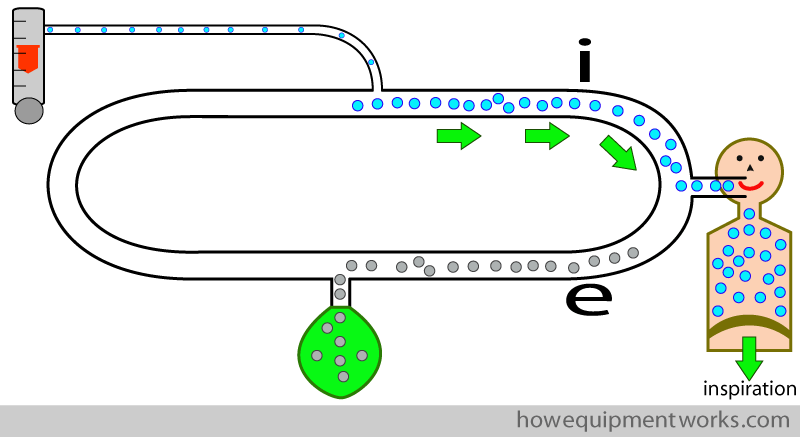
We ” force ” the patient to inspire from one part of the circle, and expire into the other part of the circle, using what are called “one-way valves “. As their name suggests, these valves allow gas to pass one way, and not the other way. The valve has a disc that opens only in one direction, allowing gases to only go in that direction. In the example below, the one-way valve is designed to allow flow in the direction of the green arrow and not allow flow to go in the opposite direction.
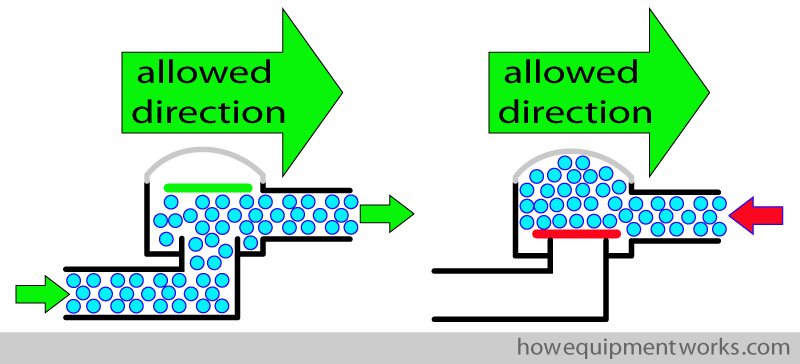
We add two one-way valves into the circle system as shown below. One allows flow only towards the patient and the other allows flow only away from the patient.

During inspiration, the valve labelled ” expiratory one-way valve ” closes, preventing the patient from inspiring the gases he just breathed out. On the other side, the valve labelled ” inspiratory one-way valve opens, letting the patient inspire gases rich with oxygen. The tubing from the inspiratory one-way valve to the patient carries only inspiratory gases, and we can therefore call it the “inspiratory tubing “.
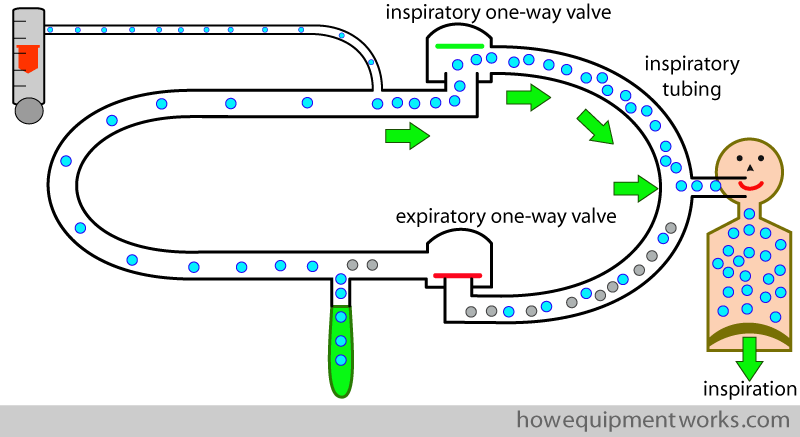
During expiration, the reverse happens. The inspiratory one-way valve closes, preventing the expired gases from going into the inspiratory tubing. Instead, the valve labelled “expiratory one-way valve” opens, letting expired gases go via the tubing between it and the patient. The tubing between the patient and the expiratory one-way valve carries only expired gases, so we can therefore call it the “expiratory tubing “.
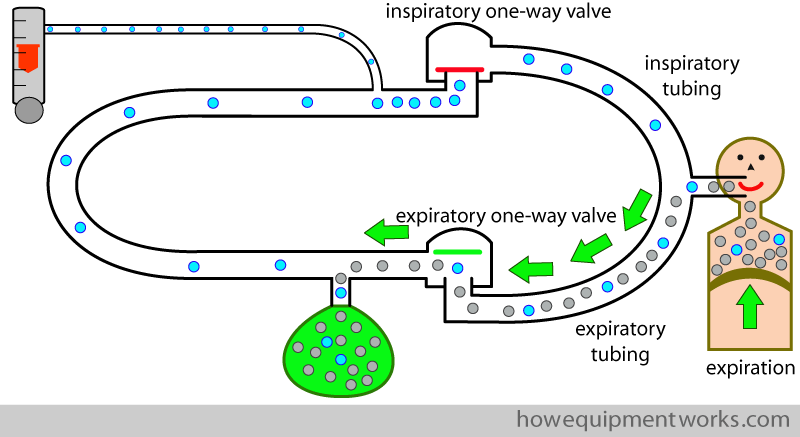
So now our patient is happy. Due to the inspiratory and expiratory one-way valves, our patient correctly inspires from the inspiratory tubing and expires into the expiratory tubing.
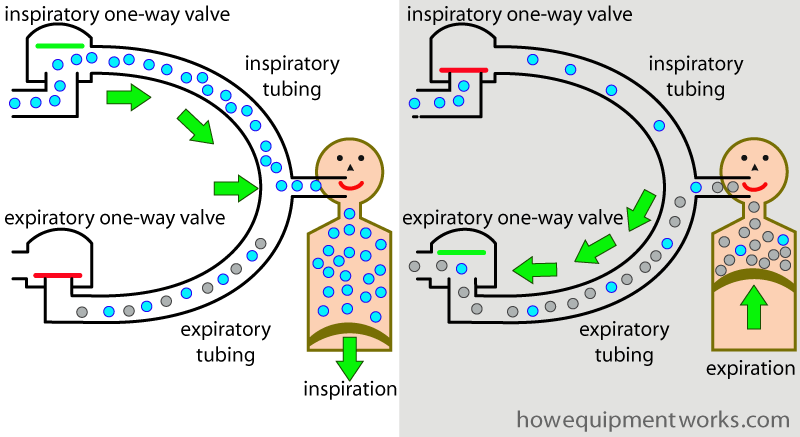
Now here is a small distraction. I am sure that you have heard about Leonardo Da Vinci. Just in case you did not know, he is the one who painted the Mona Lisa. If you are very interested in things historical, you may want to click on the image below. It will take you to a page where I have discussed the possibility that Leonardo Da Vinci, who lived 500 years ago, may have understood the concepts we have just discussed! If you visit that page, please do remember to come back here! Do also let me know what you think about it. Thank you.
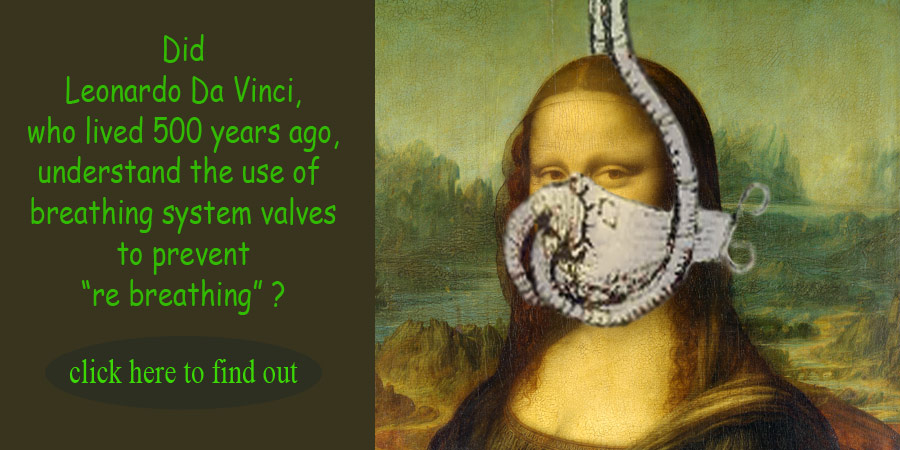
Pressure Limiting outflow valve
However, we discover another problem. We find that the reservoir bag is mysteriously getting bigger and bigger.
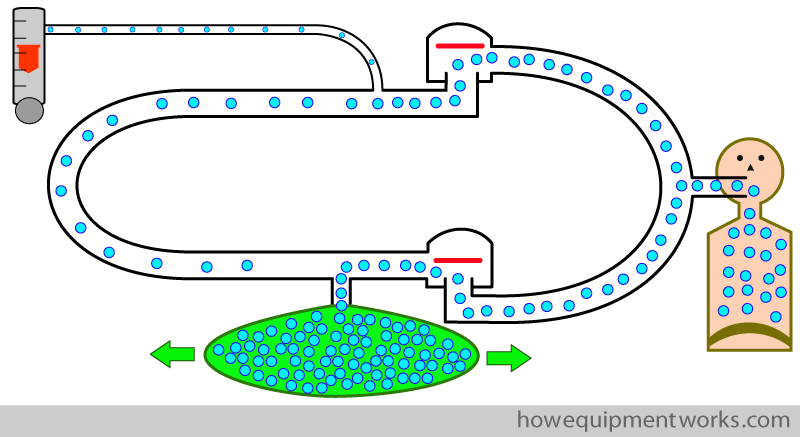
Ultimately the reservoir bag bursts!
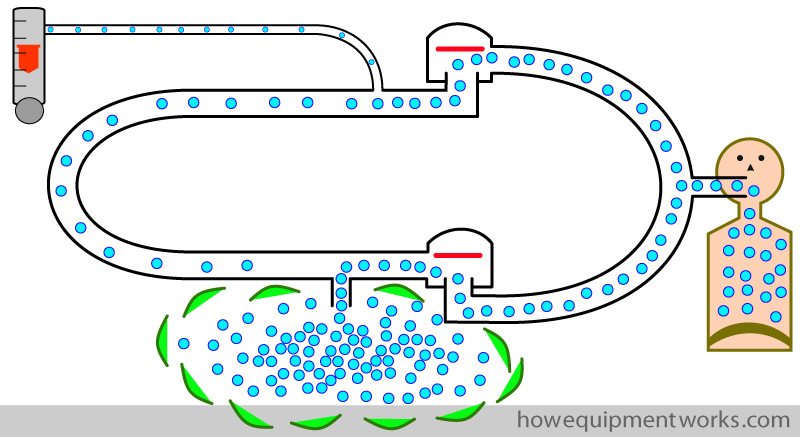
So why did this happen? The reason is that we normally give more oxygen (and other gases) than the patient needs. For example, in the setting below, we are giving the patient 1000 ml of oxygen per minute. Of this, in our example, suppose the patient takes only 250 mL of oxygen per minute. That means that every minute, there is an excess of 750 ml of oxygen. The only place that this excess oxygen can go is into the reservoir bag. Therefore this bag will get bigger and bigger, and eventually, it may burst.
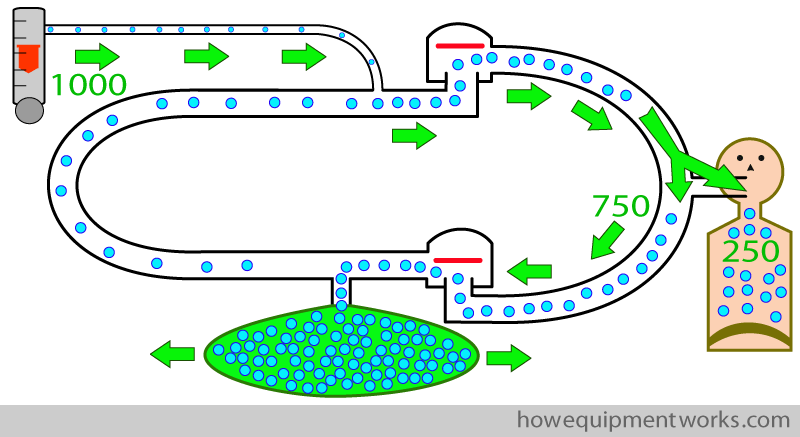
It would not be very pleasant to have reservoir bags bursting every few minutes, so we need a solution. The answer is to add a “pressure limiting outflow valve ” to the circle. This valve has a disc that is designed to open when a positive pressure develops on one side of it, thereby letting any excess gas flow out, preventing further rises of pressure.
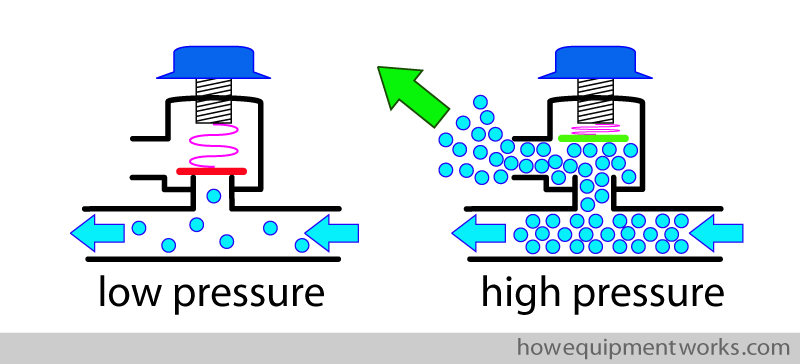
Now let us see how it works in the circle. The patient in our example is breathing spontaneously. During inspiration, the pressure in the system is low, so the pressure-limiting outflow valve remains closed.
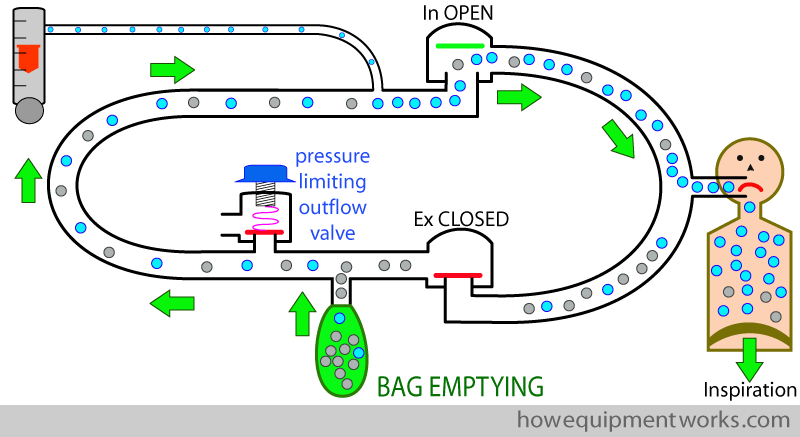
Now our patient breathes out. During early expiration, the expired gases go into the reservoir bag. Because the pressure is low, the pressure limiting outflow valve remains closed.

The expiratory gases fill the reservoir bag till it is fully distended. Once the bag is fully distended, the expired gases have nowhere to go and the pressure in the circle system rises. The rise in pressure causes the pressure-limiting outflow valve to open, releasing the excess gases (grey arrow ) out of the circle system. In this way, the pressure-limiting outflow valve lets excess gas escape and prevents a rise in the circle system pressure.
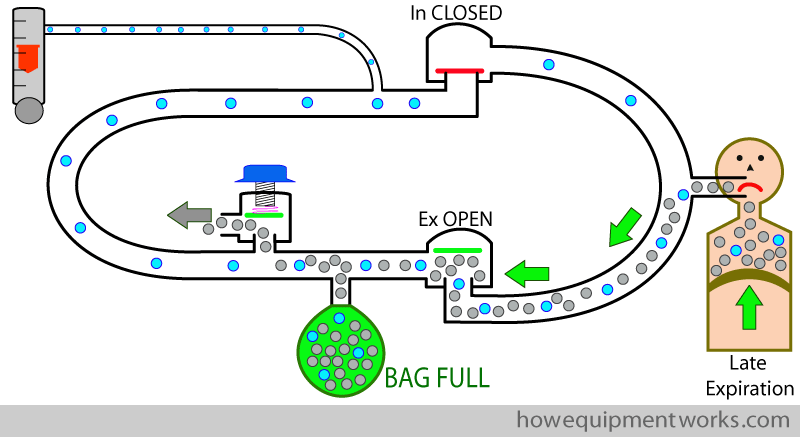

I am the author of this website. Let me briefly tell you about another website I created that you may like. I am very interested in practical ways to find happiness, especially by changing how one thinks. I have created a website that explains how to think in ways that can help one be happy. It has simple ideas that one can use in one’s day-to-day life. The website is called “Happy Thinking” and is entirely free. The website has helped me find happiness, and I am confident it can help you too. You can visit it by clicking below.

Carbon dioxide absorber
Now that our patient can inspire and expire nicely, we can ask the question; “Is he happy? ” The answer unfortunately is “No “. The reason the patient is not happy is that, as I will explain soon, he is inspiring his own carbon dioxide ( shown as grey dots ).
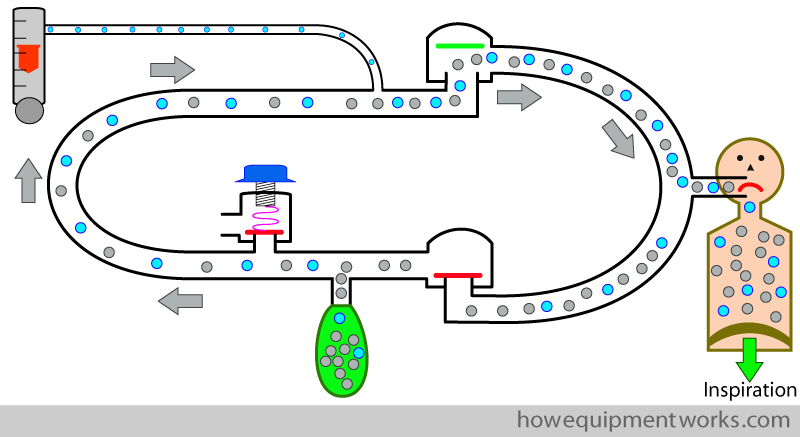
During expiration, most of the carbon dioxide goes into the reservoir bag, and once the bag is full, some of it goes out of the pressure-limiting outflow valve.
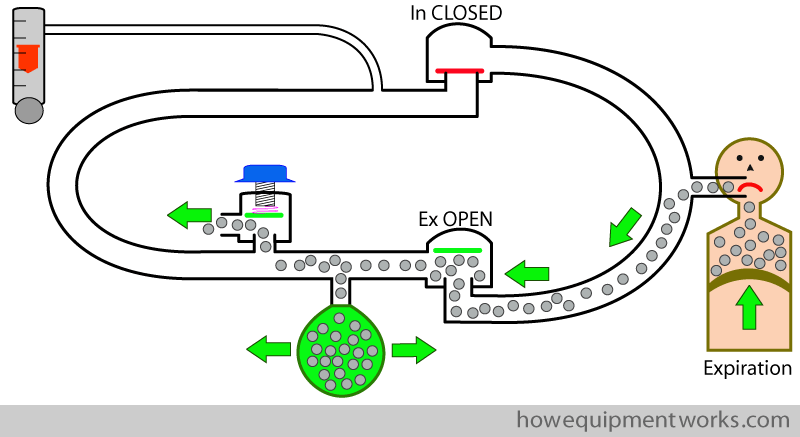
During the next inspiration, the patient breathes the carbon dioxide from the reservoir bag back into his lungs. If this situation is allowed to carry on, the carbon dioxide levels will keep on rising to dangerous, and even fatal, levels.

The solution is to use a device called a “carbon dioxide absorber ” which does, what its name says! This device is simply a container, inside of which, there are chemicals (shown in pink below) that combine with any carbon dioxide ( shown as grey dots) that passes through it. While not strictly correct in chemistry terms, one can think of it as a device that “absorbs ” any CO2 that passes through it, and for this reason, the device is called a “CO2 absorber “. We will discuss the finer details of this device later. For now, just remember that it absorbs CO2.
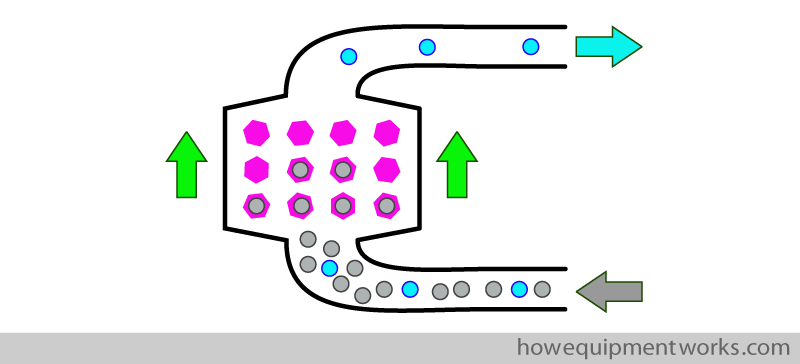
Let us include a CO2 absorber in our circle system. Now as the patient inspires, the CO2-containing gas from the reservoir bag passes through the CO2 absorber. The absorber “absorbs” the CO2, making the inspired gas CO2 free.

At least now you expect our patient to be happy, but when you look, he appears to be a little terrified instead! The reason is that he is wide awake.
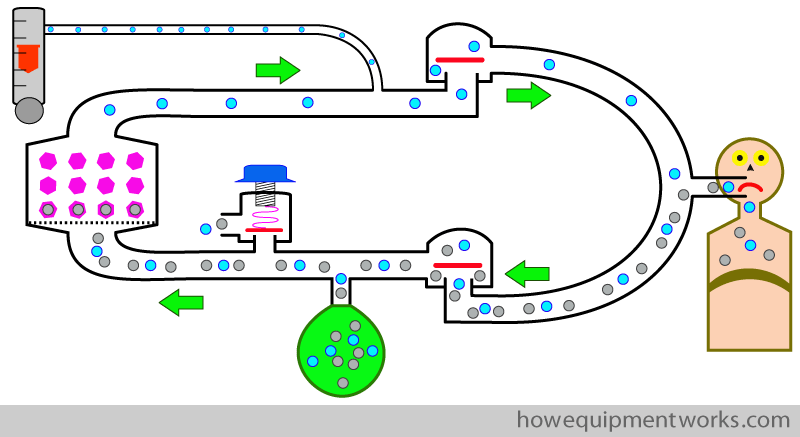
You need to give the patient anaesthetic gases to keep him asleep. We do this by adding anaesthetic vapours ( yellow dots ) to the fresh gas flow using a vaporiser.
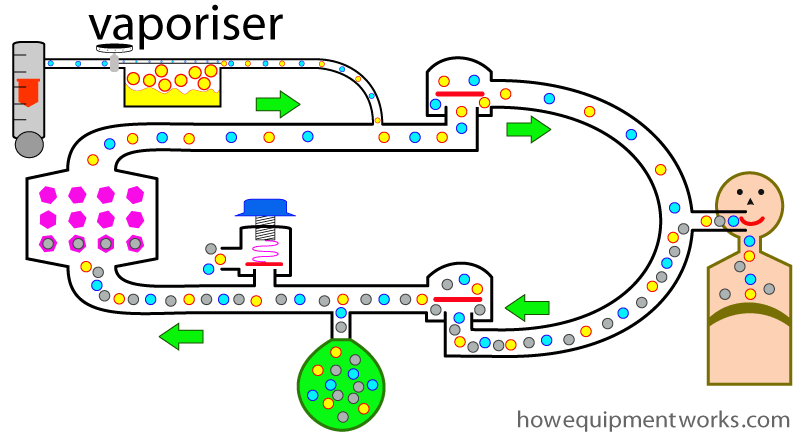
Unlike most components of the circle system such as the one-way valves or the CO2 absorber, the vaporiser is placed “outside “ circle system. Using the vaporiser from the “outside ” in this way is called “vaporiser outside circle ” arrangement or “VOC “.
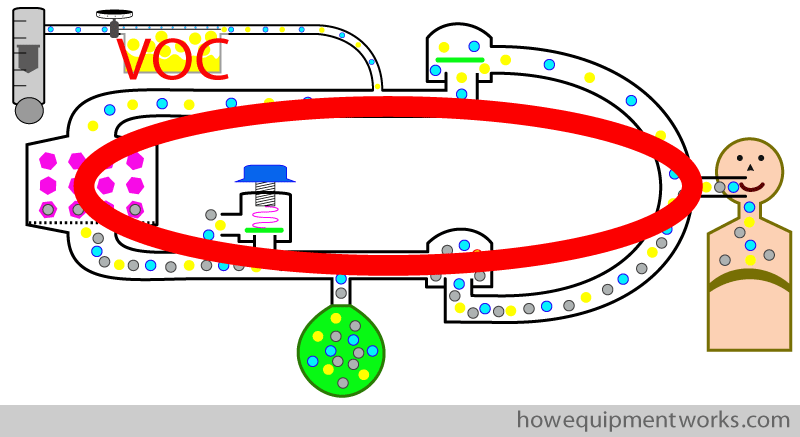
It is also possible to provide an anaesthetic agent to the patient by placing the vaporiser ” inside ” the circle system as shown below. This arrangement is therefore called “vaporiser inside circle ” arrangement or “VIC “. The use of the vaporiser in this way is complicated ( and potentially dangerous) and is very rarely used. I have never used or seen it being used this way, so let me know if you know anyone who does. The design and use of vaporisers inside and outside a circle system are very different.
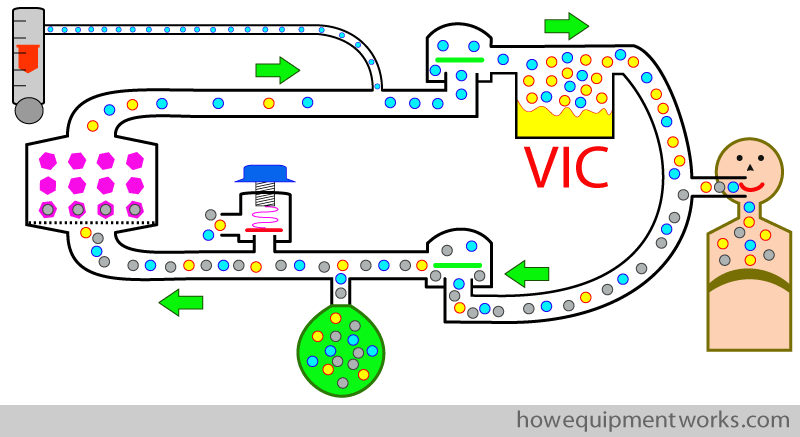
Since using the vaporiser inside the circle is very rare, I will not discuss it further. Instead, we will stick to the arrangement that is most commonly used, which is the “vaporiser outside circle” (VOC) arrangement.

Basic respiratory cycle in the circle system
Now we finally have a complete circle system and a happy patient. Let us briefly recall how the circle system deals with one patient breath ( i.e. one inspiration and one expiration) in a spontaneously breathing patient (please note that I am now describing spontaneous respiration. I will discuss positive pressure ventilation later). We start with the image below, where we are adding fresh gas flow ( yellow arrows; which contain oxygen and anaesthetic vapour) into the circle system. When the patient starts to inspire, the expiratory one-way valve closes and the inspiratory one-way valve opens, making the patient inspire from the inspiratory tubing. The inspiratory gases consist of the fresh gas flow ( yellow arrows) plus the gases from the reservoir bag (green arrows), which because it has gone through the absorber, is CO2 free. During inspiration, the pressure inside the circle system is low and therefore the pressure limiting outflow valve ( valve with blue knob in the diagram) remains closed.
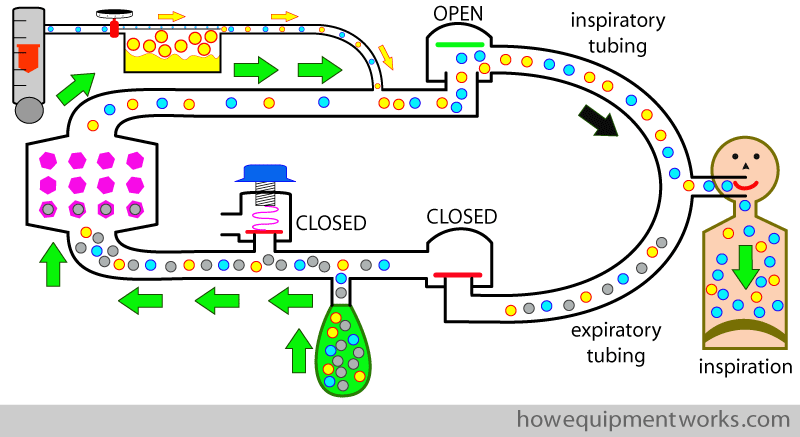
During expiration, the patient expires the following: 1. CO2 he produced 2. anaesthetic gases he did not use 3. oxygen he did not use. I will divide the expiration into two periods: early expiration and late expiration. Let us start with early expiration. In this period, the expiratory gases go into the reservoir bag.
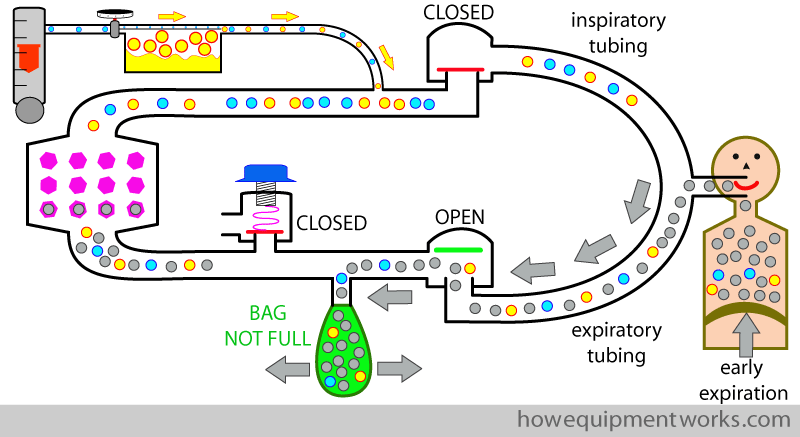
Once the reservoir bag is full, the expired gases have “nowhere to go” and the circle system pressure begins to rise. This opens the pressure-limiting outflow valve that lets the excess gases out (which contains CO2, the anaesthetic agent the patient “did not use”, and the oxygen the patient “did not use” ). The anaesthetic agent that goes out of the pressure limiting outflow valve is lost out of the circle system permanently and is considered to be “wasted”.
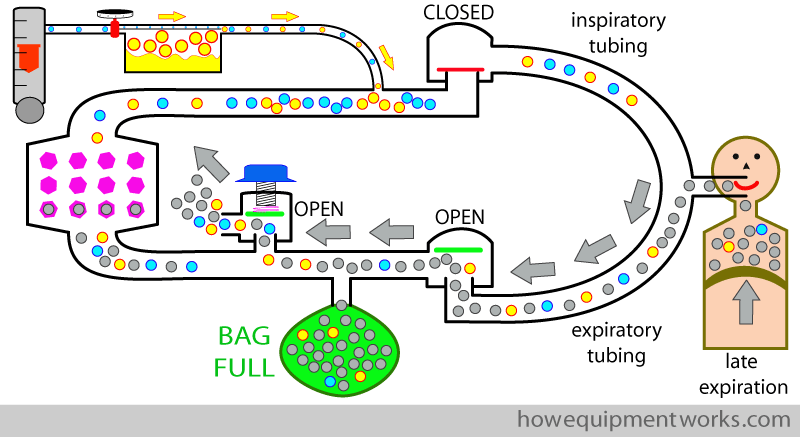
Now the cycle repeats and the patient inspires from the reservoir bag, reusing the anaesthetic agent in the bag.
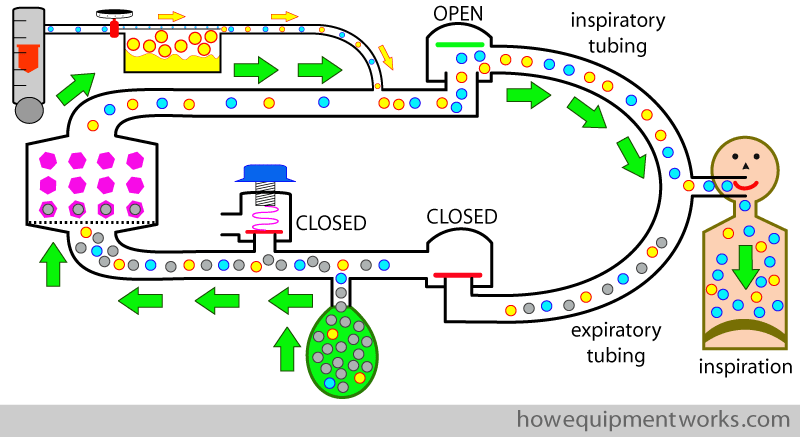
By the way, as you have seen, the diagrams I have drawn are somewhat colourful. Of course, when you revise or need to draw the circle system in an exam, you might want to do a simpler version ( perhaps something a little better than what I have drawn here !).
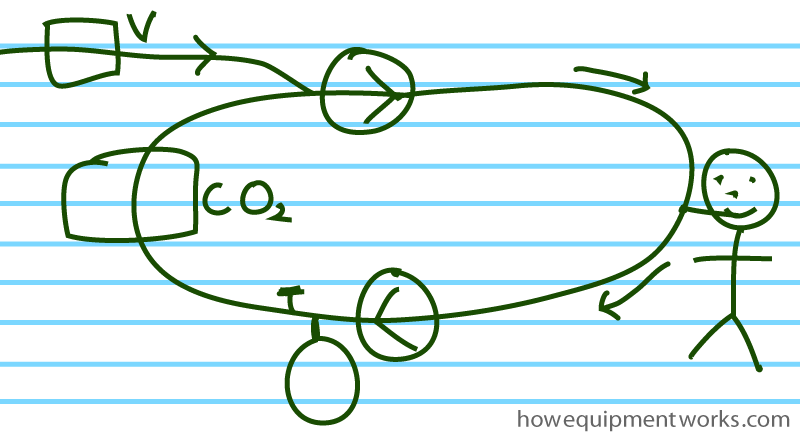
A small break for you!
Let us take a small break now. Here are two “circle” related optical illusions for you to enjoy.
The “Red Circle” illusion
In the diagram below, which red circle is bigger, the one on the left or the one on the right?
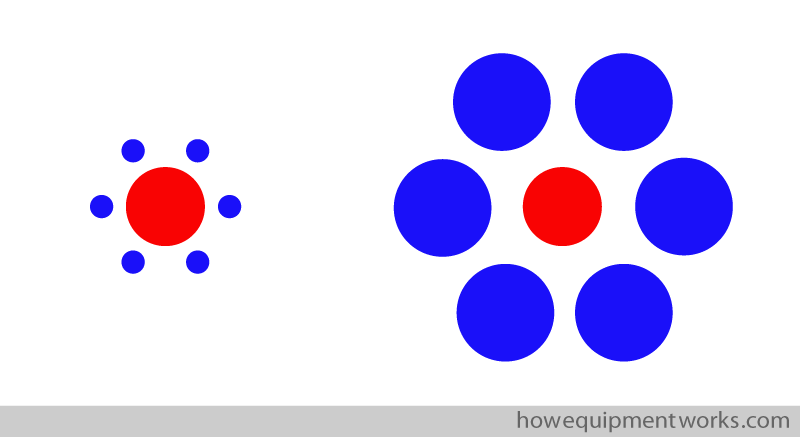
In reality, they both are exactly the same size! You can measure the two red circles shown above if you do not believe me.

“Mystery Breathing Dots”
Here is an optical illusion that I invented. You need to try it in a relatively quiet environment. Please let me know if it worked for you by clicking the feedback tab in the menu at the top of this page.
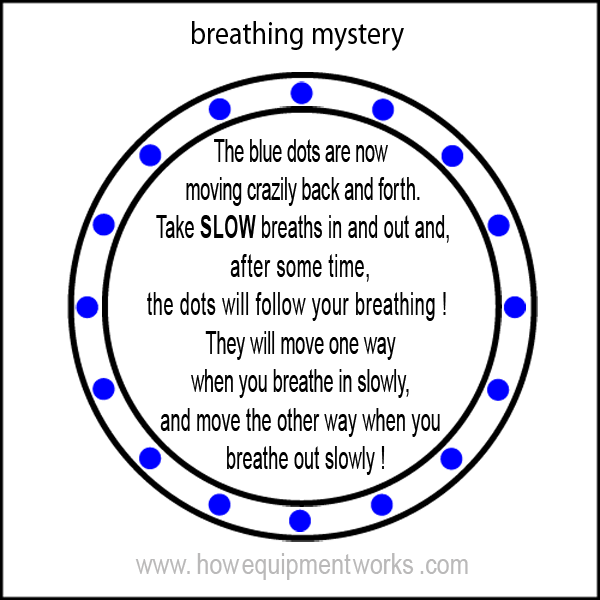
Please click the “Next” button below to read part 2 of 3. Thank you.